
The meadow brown is a butterfly found in the Palearctic realm. Its range includes Europe south of 62°N, Russia eastwards to the Urals, Asia Minor, Iraq, Iran, North Africa and the Canary Islands. The larvae feed on grasses.

Coenonympha tullia, the large heath or common ringlet, is a butterfly in the family Nymphalidae. It flies in a variety of grassy habitats, including roadsides, woodland edges and clearings, prairies, bogs, and arctic and alpine taiga and tundra. It is a poor flyer, but can sometimes be found along ditches seeking new grounds. It is a holarctic species found in northern Europe, east across the Palearctic and across North America. The species was first described by Otto Friedrich Müller in 1764.
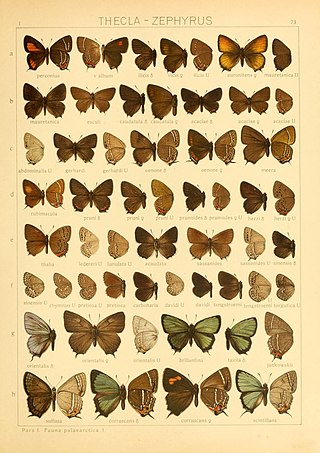
Satyrium ledereri, the orange banded hairstreak, is a butterfly in the family Lycaenidae.

Coenonympha oedippus, the false ringlet, is a species of butterfly in the subfamily Satyrinae. It is found in Austria, Belgium, the Netherlands, France, Hungary, Italy, Japan, Kazakhstan, Liechtenstein, Mongolia, Poland, Russia, Slovakia, Slovenia, Spain, Switzerland, and Ukraine. It is extirpated from Bulgaria, Germany, and Slovakia.
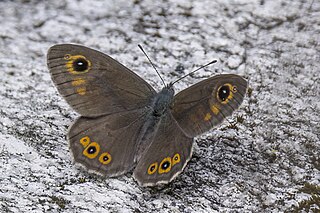
Lasiommata maera, the large wall brown, is a butterfly in the family Nymphalidae.

The bright eyed ringlet is a member of the Satyridae subfamily of Nymphalidae. It is a high mountain butterfly found in the Pyrenees, Massif Central, Alps and Balkan mountains. It has recently been confirmed to occur in the southern chain of the Carpathians.

The black ringlet is a member of the subfamily Satyrinae of the family Nymphalidae. It is a high-altitude butterfly found in Albania, former Yugoslavia, Bulgaria, Greece, and Romania.

The sooty ringlet is a member of the subfamily Satyrinae of family Nymphalidae. It is a high-altitude butterfly found in the Alps and Apennine Mountains on heights between 1,900 and 3,000 meters in Austria, Germany, France, Switzerland, Italy and Slovenia.

Coenonympha arcania, the pearly heath, is a butterfly species belonging to the family Nymphalidae.

Coenonympha hero, the scarce heath, is a butterfly species belonging to the family Nymphalidae.

Coenonympha glycerion, the chestnut heath, is a butterfly species belonging to the family Nymphalidae. It can be found in Eastern Europe and east across the Palearctic to Siberia and the Caucasus to North Korea.
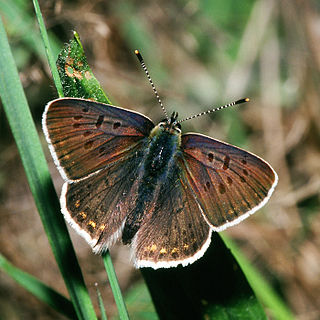
Lycaena tityrus, the sooty copper, is a butterfly of the family Lycaenidae. It is found in Europe.

Polyommatus amandus, the Amanda's blue, is a butterfly of the family Lycaenidae. It is found in the Palearctic realm.
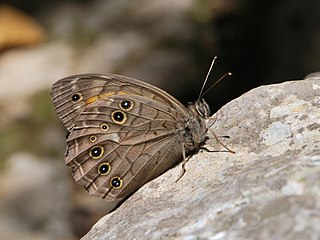
Kirinia roxelana, the lattice brown, is a butterfly of the family Nymphalidae. It is found in southeastern Europe and the Near East. The butterfly is on wing between May and July. The larvae feed on various grasses.
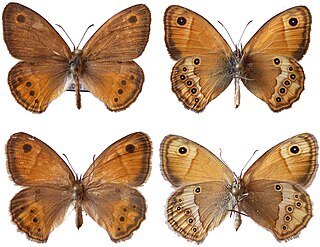
Coenonympha dorus, the dusky heath, is a butterfly of the family Nymphalidae. It is found in south-western Europe and North Africa.
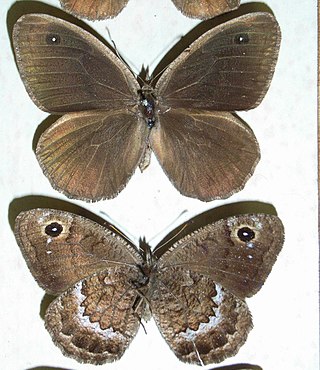
Satyrus actaea, the black satyr, is a butterfly of the family Nymphalidae. It is found in South-Western Europe, Asia Minor, Syria, Iran and Baluchistan.

The twin-spot fritillary is a butterfly in the family Nymphalidae.

Coenonympha corinna, the Corsican heath, is a butterfly in the family Nymphalidae

Coenonympha amaryllis is a small butterfly found in the East Palearctic that belongs to the browns family.

Polyommatus damone is a Palearctic butterfly in the Lycaenidae family.





















